-
#514 – The Day of the Triffids (2009)










The Day of the Triffids (2009)
Film review #514
Director: Nick Copus
SYNOPSIS: A solar flare visible across the world has the effect of making everyone blind, leading to the collapse of society and government. This also has the consequence of releasing the Triffids, man-eating, mobile, plants into the world after their containment facilities fail. Bill Masen, a scientist who studies the triffids, avoids being blinded by the flare due to having an eye operation, and awakens to find he is one of only a few people still able to see. Bill navigates the remains of civilisation, teaming up with broadcaster Jo Playton to try and survive this new world, and also to stop the triffids from feeding on the sightless population…
THOUGHTS/ANALYSIS: The Day of the Triffids is a 2009 two-part TV series, based on the 1951 novel of the same name by John Wyndham. The plot of the film is updated from it’s origins in the 1950s, making the triffids, a race of man-eating plants that can move, the answer to global warming through the oil they produce as an energy source (the original novel was similar, but didn’t have the global warming angle). Bill Masen, a scientist working with the triffids, is attacked by them and has to have an eye operation to save his sight. Meanwhile, a solar flare that is visible worldwide causes the vast majority of people to lose their sight. Bill, having his eyes bandaged, is one of the fortunate ones, and unwraps his bandages to find society collapsed and everyone around him stumbling around blind. The plot of the series is more closer in many respects to the original novel than the 1962 film, and the changes it makes to bring it up to date fit in well. One of the main issues I have with the story is the unrelated events of the solar flare (meteor shower in the original) and the release of the triffids. Given that both cause blindness, it makes it seem like there is some connection between the two, whereas apparently it is just coincidence. The 1962 suggested a link between the two (that the triffids came to Earth by a meteor), but no such connection here. I’m not sure how convincing it is either that so many people went blind, when apparently you could avoid it simply by having your eyes covered, or being underground (such as Jo in the London underground), surely that would leave a lot more people sighted? Nevertheless, most of the main plot points from the book are there, but slightly tweaked to make a more conventional flowing narrative. The original novel was very much a post-apocalyptic survival story, whereas this adaptation fits the characters and story into more conventional film roles, for example, separating characters into specific scenes and settings, and having an overarching villain. The series flows fine enough, but there’s a point in the middle where things feel a bit without purpose and lost, and has no idea what to do with the characters.
The characters themselves have likewise had a few changes to reflect the more modern setting, and the serial format. Bill Masen is a fairly unremarkable lead, but that’s okay, because the story is more interesting when it focuses on the world rather than the characters. Bill’s character is expanded by introducing a personal relationship with the triffids, due to his parents being researchers that studied triffids, and his Mother being killed by one. It is an element that comes into play more in the latter half of the film when Bill meets his Father, but it all feels very unoriginal. There’s also this strange recurring flashback from when Bill was a child and his eyesight was saved after a triffid attack by a shaman and a mask of some sort, but I didn’t really get the significance of it, and it really only pays off in the final minutes for an insignificant bit. Torrence, played by Eddie Izzard, takes up the villain role, and he is set up as a man who will do whatever it takes to survive (he mostly replaces Beadley from the original novel). His quirky, whimsy personality does feel a bit out of place in a post-apocalyptic setting, and I don’t think the series needs an overarching villain in a world where the world itself is the biggest enemy, along with the triffids, of course. One thing that is consistently evident is that nobody seems to know how to write women and children: Jo is the female lead, but her dialogue and everything she does just feels so ineffectual that it’s almost like she isn’t there for the most part. When the young girl Susan and her sister turn up later on too, their characters just don’t go anywhere or develop a bond with the others. There is a severe lack of coherence and relationship building between the characters which is overlooked in the streamlining of the plot into a two-part series.
Production-wise, the series looks good, with plenty of scenes that show off a ruined London, and plenty of extras that populate the chaotic streets. The triffids themselves are CG monsters that are mostly shown obscured in shadows or partly obscured, but I think that’s probably for the best, as there’s no way to make CG walking plants look completely threatening. There’s a good sense of scale, and some competent production, but The Day of the Triffids has a certain blandness borne from some streamlining elements of the plot to fit the series format, and an inability to write some of the characters to be in anyway significant. It’s watchable, mildly entertaining, but yes…bland.
-
#513 – Where Did All the People Go? (1974)








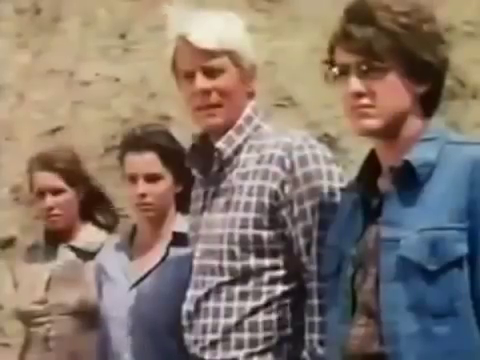

Where Have All the people Gone? (1974)
Film review #513
Director: John Llewellyn Moxey
SYNOPSIS: Steven Anders and his family are enjoying a camping trip in the mountains of California. While Steven’s wife, Barbara, returns home for work, the rest of the family stop and enjoy the remainder of their holiday. While exploring a cave, an earthquake strikes and they head outside to find that some form of solar flare has happened, and they can get no communicate with the outside world. The family head home to try and find Barbara, finding that almost everyone in the world has vanished, leaving only white powder where their bodies once were…
THOUGHTS/ANALYSIS: Where Have All the People Gone? is a 1974 TV movie. The film focuses on Steve Anders and his family, as they are on a camping trip in the Californian mountains. Steve’s wife Barbara has to return home for work reasons, leaving Steve, their two teenage children, and a local farm-hand. The family are down in a cave when an earthquake hits, and they escape to find the farm-hand outside that some form of bright flash happened in the sky at the same time. Unable to get into any contact with anyone, and with the farm-hand suffering what appears to be some form of radiation poisoning, the family try and get back home to Barbara, along the way finding that nearly everyone who saw the flash of light has died and become a heap of white dust. The story is focused around Steve and his family, and the people they pick up and encounter along the way. Initially starting with no answers, they slowly build up theories about what is happening, but their focus is always on getting home to their wife/mother. The film starts off pretty empty, and with characters that are very cookie-cutter and without personality, but slowly, they start to build up some particular responses to what is going on around them, and things start to pay off. The different scenes are a bit hit-and-miss: sometimes they work, sometimes they don’t. As such, the film can feel a bit uneven and disjointed. I don’t think there’s too much original in the film’s portrayal of a world where everyone has disappeared (an idea not unfamiliar to post-apocalyptic films), but it also avoids the common depictions of post-apocalypse scenarios by tuning away from global nuclear fallout and focusing on a family drama. Given that this is a TV movie, which typically focus more on entertainment and action, it is a rare example of such a movie that instead takes its subject matter seriously without the frills.
As mentioned, the characters are very much plain, stereotypical cut-outs, but they do start to grow a little as the film goes on. Steve keeps his family together, while his son David is a science-based person, who unravels a little as the film goes on. Deborah doesn’t really have too much to do other than do some occasional narration (which doesn’t add too much), and the characters of Jenny and Michael, whom the family they pick up along the way, have small, but interesting character arcs that adds something of substance. By the end of the film, there’s some good dialogue and twists that have cohered the characters into a good unit, but they never fully shake off that mould from which they begin.
The open-ended nature of the film leaves us with no real answer about the state of the world and it’s survivors: all we know is about are the characters we travel with, and who they encounter, which says very little. This isn’t necessarily a bad thing, but might not be for everyone who might want the journey to have a more substantive pay-off. When we are given explanations to what is going on, the science seems a bit far-fetched, such as people being turned into white dust being caused by a large solar flare and a particular dominant gene is a bit much the more you think about it. Again, like most things in this film, if you don’t think too much about it and focus on the characters and the depiction of the post-apocalyptic world, you have something that is mildly interesting to watch, if you give it a chance to get going. It’s nothing mindblowing or groundbreaking, but there’s some competency at work that brings the film together. In terms of TV movies, you can do worse, but you can certainly do better.
-
#512 – The Day of the Triffids (1962)





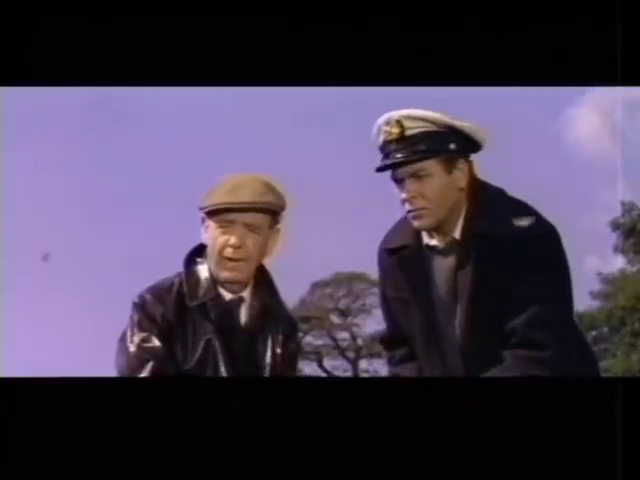



The Day of the Triffids (1962)
Film review #512
Directors: Steve Sekely, Freddie Francis
SYNOPSIS: After a meteor shower that is seen across the globe, nearly everybody on Earth is blinded by it. Billy Masen, a merchant navy officer, avoids being blinded as he has had his eyes bandaged up from an operation. He takes off his bandages to find he is one of the few people in the world who has not been blinded, and also that the meteor shower has released a strange plant called triffids that are multiplying rapidly, and attacking people…
THOUGHTS/ANALYSIS: The Day of the Triffids is a 1962 sci-fi horror film based on the novel of the same name by John Wyndham. The film begins with introducing Bill Masen, A merchant navy officer, who is resting in hospital after an eye operation. While his eyes are covered up in bandages, a meteor shower seen across the world blinds almost everybody on Earth. Bill is unaffected because of the bandages covering his eyes, and wakes up the next morning to remove his bandages and find that everyone else around him has gone blind. This has caused not only to society to break down and all services and communications to cease, but also the meteors have released a strange species of plant called Triffids that can move and attack people. The film is a balance between a post-apocalyptic survival film, and also a classic B-movie monster movie, and for most part, it is balanced quite well. The tone of the film remains serious and desperate, without too much of that low-budget b-movie tone undoing it. There’s also a good balance between the two sides of the story presented to us, with Bill and those he meets trying to survive in the world, and scientists Tom and Karen Goodwin, isolated from the world at a remote lighthouse, try to investigate the triffids and find a way to stop them, separating the explanations and exposition from the drama-heavy story of Bill and those around him trying to survive. It should be noted though, that the film is not a particularly faithful adaptation of the book, as it moves some of the settings and omits some characters. There are other adaptations that are more faithful, so you may want to look there if you want something closer to the book.
Apart from the good balance of characters and tone, there’s also some good shots and settings that set the scene rather well. Shots of the streets of London and Paris deserted are rather striking, and the scenes exploring the fallout of everybody being blind, from mass panic and planes being unable to land gives us some dramatic moments with big consequences, but the main focus is on Bill and his group’s isolated struggle for survival. The triffids themselves look like a b-movie creature, but manage to be quite menacing and threatening at some points, particularly in one scene where you see a hoard of them amassing behind an electric fence.
The ending is perhaps the weakest part of the film, and again something that deviates from the original novel: it turns out that the triffids dissolve in seawater…and that’s it. The world is saved apparently. It’s an ending twist similar to The War of the Worlds, which released a film adaptation in 19053, and had the invading Martians unable to survive in the earth’s atmosphere outside of their protective environments. We’re not given an insight into how the world is meant to carry on with nearly everybody blinded, but I suppose Bill’s story has a solid ending with him and his cohort reaching safety. One other notable aspect of the ending is that some survivors who have been trapped in a submarine emerge, and…go to a church to give thanks for their survival. This is an odd choice for an ending, particularly because Wyndham was not a religious person, but a a fair few of these sci-fi horror films (The Day the Earth Stood Still springs to mind), where ultimately God and religion are shown to still be all-powerful in the face of science. It’s an ending that comes out of nowhere and isn’t necessary, but is not uncommon in films of this era. Overall, The Day of the Triffids has some good aspects to it: it benefits from having the structure of the novel to balance out the different aspects of the film, but becomes a lot weaker when it deviates from it. The Triffids are a fairly terrifying monster in particular scenes, and are more memorable than a lot of monsters, but their undoing is a little contrived and uninspired. A good example of a b-movie monster flick, with some post-apocalyptic elements that heighten the drama.
-
#511 – Killdozer (1974)










Killdozer (1974)
Film review #511
Director: Jerry London
SYNOPSIS: At a remote construction site, a group of workers uncover a strange meteorite while using a bulldozer. This vehicle becomes possessed by the strange energy from the rock, and begins killing off the workmen at the site. The survivors must find a way to survive and put a stop to the rampaging vehicle before it bulldozes them as well…
THOUGHTS/ANALYSIS: Killdozer is a 1974 TV movie which, as the title suggests, is about a killer bulldozer. The film is a typical sci-fi horror film, with the less typical set-up of the big bad being a construction vehicle. Nevertheless, the plot unfolds as you would expect, with the bulldozer killing off the workmen at the site one by one as they try to work out what is going on and how to survive. The premise of the villain being a bulldozer is the only unique aspect of the film, and as you might imagine, it brings with it a whole host of implausibility about the whole set-up. The film is based on a remote island with only one two-way radio, so when it is destroyed by the bulldozer, they have no means to communicating with anyone (back in 1974 when nobody had mobile phones…). This isn’t the really big problem though: it just seems like a killer bulldozer would not be that much of a threat, given both how slow it moves, and also that it would not be able to get up large inclines. As you might suspect, the characters don’t really seem to consider this, and keep meeting their end with the bulldozer slowly ploughing into them. The film does try to justify it’s decisions and emphasise the futility of the situation, but in a film about a killer bulldozer, you’re never going to be completely convinced of the severity of the entire situation. Then again, it’s a very no-frills production, with a lack of special effects that gives it a gritty rootedness, which makes it in a roundabout way, more believable.
The characters are a group of pretty down-to-earth characters: being a group of construction workers, they all have a similar outlook and mindset. As such they don’t all have distinct personalities on a trope-per-character basis, but while they all overlap, that makes sense given they all have the same job and are all put into the same situation. Clint Walker and Robert Urich as the leads have just enough differences in their personalities to make a dynamic, conflicting relationship form between the two of them, but that’s all the character development you really get. As you might expect, the bulldozer itself doesn’t have much of a character because…it’s a bulldozer. That’s not to say you can’t give murderous vehicles personality and make them scary, because there are quite a films that have done so (albeit after this film was released). I think if there was more of a logic to how the bulldozer was operating, or why it was running amok it would make it more interesting.
One of the more surprising aspects of the film is that it is actually based on a short novel released in 1944, and the basis for a comic adaptation released in the same year as the film. What is also interesting is that the writer of the novel, Theodore Sturgeon, did the re-write of the film too. There’s a lot of changes from the novel, such as being set in the “present” rather than the “present” of the novel in WWII. Being a TV movie, the budget probably wouldn’t have been able to account for the origins of the energy that possesses the bulldozer; which in the original novel was a remnant of a weapon used by an alien race against the ancient race that lived on the Earth (the comic also explored this a little too). In a way, this actually helps the film, insofar as it keeps the film grounded and avoids any fantastical or ridiculous sci-fi elements that open it up to mockery or make it even more unbelievable. Killdozer is about what you would expect from a TV movie: a low budget production that is nothing particularly ground-breaking. This down-to-earth production actually helps the film rather than hinders it though, and sharpens focus on the characters and this bizarre situation they find themselves in. The whole premise is still absurd, and there’s definitely better “killer vehicle” movies out there, but this one works well with what it has.
-
#510 – Trancers 6 (2002)








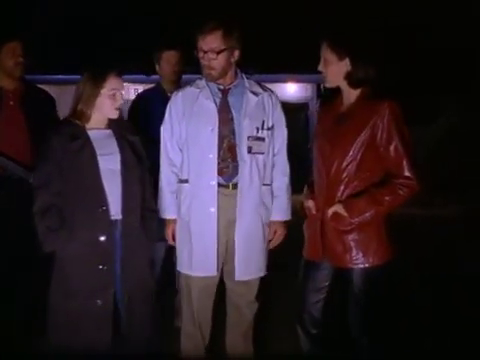

Trancers 6 (2002)
Film review #509
Director: Jay Woefel
SYNOPSIS: Trancer hunter Jack Deth is once again sent “down the line” back in time to hunt down a new Trancer threat. He ends up in the body of his daughter, whose lifestyle certainly doesn’t fit with his own. In this new body and life, Deth must hunt down the Trancer threat and put a stop to it before his daughter is killed and he is wiped from existence.
THOUGHTS/ANALYSIS: Trancers 6 is a 2002 sci-fi film and the sixth film in the Trancers film series. In a return to the original premise of the films, Trancer hunter Jack Deth is sent back in time to inhabit the body of his daughter in the 21st century, to find and counter a new Trancer threat before they can kill his daughter and erase his existence. After the weird fantasy adventure of Trancers 4 and 5, this one returns to a more simple sci-fi action film. The absence of Tim Thomerson as Jack Deth in this film removes the only redeeming aspect of this film franchise: his caricature of cheesy action heroes was so ridiculous that it would be entertaining. His appearances in this film are limited to archive footage from previous films, and a stunt double playing his barely visible body strapped to a table in the future. Instead, we get Jack inhabiting his daughter Joanne…who is also his great-great grandmother, managing to create some sort of paradox or another, but this is glossed over, as the film doesn’t really focus on details in general: it’s straightforward, to the point, but that lack of detail really slows the film down after the first act, where it becomes apparent the film has very little substance. The film manages to feel both like a low-budget film from both the 80′s and the early 2000′s at the same time, which I suppose makes sense, but being released eighteen years after the first film, there’s very little progress to show in terms of story, production, lore, or design.
Joanne (Jo) is basically everything Jack Deth isn’t: a tee-total, vegan, meek nerd with a dull career. The majority of the humour in this film basically derives from Jack Deth being his foul-mouthed, smoking, misogynistic self, retorting everything that is said to him with a cheesy or inappropriate one-liner. The film is very much a one-trick pony in this regard, but honestly, it retains it’s entertainment value throughout the film, and it is genuinely funny in parts by virtue of how purely cheesy it is. This has always been the Trancers films best aspect, and it is good to see that even without Thomserson, they are still able to pull it off. Zette Sullivan as Jo Deth manages to pull off Jack’s style of speech and deliveries pretty well, and you can really believe that Jack is inhabiting her body. The line delivery is a bit flat sometimes, but there’s definitely worse things about the film. The rest of the cast; from the supporting characters to the villains, really do not leave an impression. The new Trancer threat isn’t really explained after Jack supposedly wiped them all out in the previous films: apparently it has something to do with meteors and radiation or something, but as mentioned, the intricacies of the plot aren’t really the focus of the film.
Being a production by Full Moon Entertainment, you should expect a low-budget production, but this is bad even by their standards. The sets are limited to empty building, corridors, and some rural outdoors scene in the middle of nowhere. The special effects are really bad, but thankfully only used once when a guy is thrown out of a high-rise building, resulting in a hilariously bad effect. The gore and other effects are pretty standard, and are nothing too noteworthy; a lot of the production is very much what you would expect from these films, but there’s also a distinct lack of trying to do anything unique, and an added amateur-ness in the camera work, acting and locations. Trancers 6 is a bad film, there’s no escaping it: it is dull, poorly produced, and very threadbare on plot that it feels somewhat pointless. Despite all of that though, it still manages to recapture the absurd, over-the-top character of Jack Deth even without Thomserson’s portrayal, and the twist of putting him into a young woman’s body is just different enough to provide new entertainment value in the whole set-up. The film definitely relies on this sole gag to carry the whole film, but if you’ve made it through the previous Trancers films and got some laughs and entertainment from them, you can probably get a little more out of this last one.
-
#509 – Godmonster of Indian Flats







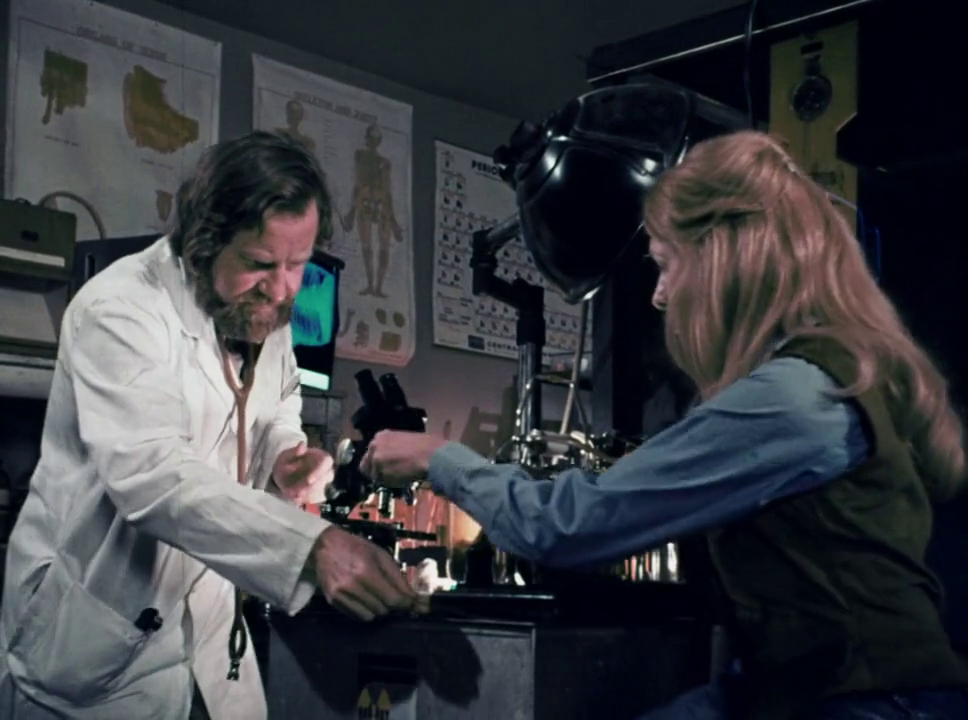



Godmonster of Indian Flats (1973)
Film review #509
Director: Fredric Hobbs
SYNOPSIS: Following a big gambling win and passing out in a drunken stupor, rancher Eddie finds a strange, large embryo on his ranch. Professor Clemens takes the embryo to his laboratory for study. meanwhile, a businessman attempts to buy property in the town for mining development, but the mayor and the secret society of the town have other ideas, as they wish to preserve the legacy of their town as an “old west” place for tourism…
THOUGHTS/ANALYSIS: Godmonster of Indian Flats is a 1973 western horror film. In the opening, we see rancher Eddie winning big on the slots and getting taken for a ride by some of the townsfolk. He is taken back home and awakens the next morning to find a large embryo. Local anthropologist Professor Clemens and his research assistant Mariposa take the embryo to incubate it, where they believe it to be the monster that has been talked about in local legends. Meanwhile, a wealthy businessman named Barnstable is trying to buy land in town to get the mines operational again, coming up against the mayor who wants to preserve the “old west” feel of the town to keep tourists coming in. These two main threads of the story are the main issue of the film, mainly because they develop almost separately from each other, only really crossing over at the end. If you want to see a “weird west” type of film consisting of a Western combined with other genres, you don’t really get that because the genres stay very separate for the vast majority of the film. It’s really difficult to figure out what is going on in the story or what the motivations for the characters are when there are all these unconnected things going on. The film sets itself out as some kind of western horror (judging by the title), but most of the film sees the monster stuck in a laboratory, and instead focuses on the goings on of this dusty town. There’s definitely a lot of effort put into creating the atmosphere of an old west frontier town in the Southern U.S., and it does set it up fairly well in the beginning, but when it comes to building a set-up and characters around it, there’s very little cohesion and direction to drive the film.
There’s plenty of characters that are laid out and the setting is constantly built-up through the expansive shots of the landscape, and the dusty, isolated town. There’s definitely a vision in that regard, but there’s so many strange decisions with respect to the story that it becomes a series of bizarre events that are consistently inconsistent. The scene with the funeral of a dog whose death was staged to make Barnstaple look bad is just so absurd I don’t know how you’re supposed to take it seriously. The acting is also pretty dire so as to alienate the viewer from the story even further. The monster itself we see in bits and pieces until the end of the film, where we are treated to the form of a deformed, mutant sheep of some sort. Trying to make a sheep look threatening seems like a fruitless endeavour, but they certainly tried regardless. It always, however, looks like a sheep, and so isn’t that scary or horrifying.
There’s definitely some arguments for it being a “so bad it’s good” film, with the pure weirdness in the story and it’s random jumps in tone that come out of nowhere. In this way, it is certainly entertaining and not boring, but you will be constantly wondering how all this fits together. I feel like there’s definitely a vision that grounded the production of this film, specifically in brining this old west town and it’s population and culture to life, but anything on top of that, from the story, the characters, and the whole monster thing are so convoluted that it’s difficult to take it seriously. Overall, Godmonster of Indian Flats is just plain weird: it has all of these things it wants to do, but no idea how to bring them together. The parts where the film tries to take itself seriously are offset by the incomprehensible plot, unimaginative characters, and flat acting. Maybe some people would describe it as “so bad it’s good”, and there are certainly some points where that is the case, but on the whole, I think it just falls short of having that entertainment value.
-
#508 – Star Wars Episode VI : Return of the Jedi (1983)










Star Wars Episode VI: Return of the Jedi (1983)
Film review #508
Director: Richard Marquand
SYNOPSIS: Luke Skywalker and his friends attempt to rescue Han Solo from the clutches of Jabba the Hutt, meanwhile, the evil Galactic Empire are busy building a new death star, leading to a battle between the empire and rebels that will determine the fate of the galaxy…
THOUGHTS/ANALYSIS: Star Wars Episode VI: Return of the Jedi is a 1983 science-fiction film and the final film in the original Star Wars trilogy. Set one year after the events of previous film, in the opening we see Luke Skywalker and his friends attempting to infiltrate the palace of Jabba the Hutt and rescue their friend Han Solo, who was frozen in carbonite at the end of the previous film. Like in Episode V, the gap between films presents a bit of an issue plot-wise, perhaps more so here. For example, the opening title crawl just casually outlines the fact that the empire is constructing a new death star, which was not hinted at or set up at the end of the previous film, and to just reveal this significant plot-point (regardless of it being a bit recycled from the first film) as a bit of text in the opening seems to dilute the impact of what could have been a significant moment in the film. The first act of the film as mentioned takes place one year after the events of the previous film and is essentially a rescue mission to free Han Solo. Again, there’s issues with the plot that immediately surface: why did they wait a year to rescue Han Solo? Why do it now when the empire is constructing a new death star? The Empire Strikes Back had a similar problem with it’s three-year gap between it and A New Hope, where it seemed like the relations between the characters hadn’t changed much in three years. It just seems to be a consistent thing in these films that the gaps between them aren’t well thought out (perhaps due to the fact that the trilogy wasn’t planned out in advance). The first act itself is a good set-up, with all of the heroes working together in their own ways to help free Han Solo, and it closes the arc with Jabba the Hutt set up over the trilogy, but in the context of the wider story it seems like it takes up too much time when the fate of the galaxy is on the line and the main rebels take time out to save one person. The scene with Luke taking a big detour to see Yoda, just so he can confirm that Darth Vader is his Father, is of little significance, and I’m not sure why it was kept in. Apparently it was filmed because they needed to confirm that Vader wasn’t lying about him being Luke’s Father, but as a viewer, this didn’t seems like an issue that arose for me, and even if it was, it could have been handled some other, quicker way, instead of making a big detour, and an extended death scene that just tries to be overly-dramatic for some reason. The film refocuses itself after this and sets the stage for the final battle well and also giving enough space for your favourite characters, but there are definitely some issues with the story which are harder to overlook than the ones in The Empire Strikes Back.
All of your favourite characters return in the film, and they are for the most part consistent with what we know about them. There’s not much development, but I think everything is pretty set up for the climax character-wise. Luke attempts to come across as a hardcore Jedi now as he calmly walks into Jabba’s palace and decimates him with his plan, but Hamil as an actor still doesn’t have that feel of someone who is bad-ass, or can lean into the more dramatic moments, like Yoda’s death. Leia’s character doesn’t have a specific arc, but her response to finding out that she is Luke’s sister, that she has “somehow always known” is a bit weird, particularly in the context of the love triangle between her, Luke and Han that was part of the first film, and her kissing Luke on screen twice. Apart from that, she’s still a strong character, but the plot just doesn’t seem to affect her on a personal level. Han’s character feels pretty diluted in this film: he mostly just reacts with grumpy quips about every situation. he’s still one of the most definitive characters, but his character just isn’t doing much new. Apparently one of the original plans was to have him die, but George Lucas overruled it on account of the potential to hurt merchandise/action figure sales. You can probably trace a lot of the decisions about the film to Lucas being concerned about merchandise sales (which was his main source of income for the films). The new characters, such as the new stormtrooper designs on Endor, Admiral Ackbar, and especially the Ewoks would no doubt drive a new wave of merchandise sales, particularly among younger people.
In terms of the villains, Jabba’s villain arc is quite nicely closed off, even though he is only mentioned and appears briefly throughout the films. Nevertheless, we have a good idea of who he is and what he does. Vader’s story in this film shifts a fair amount: he changes from a ruthless ruler killing his own people in the previous films, to a bit of a lackey to the Emperor in this one. Maybe this again an attempt to not make him too scary to children, but also I guess it ties into the sub-plot of Luke attempting to “save” his Father and turn him away from the dark side. This is something that just suddenly happens in this film, and is in no way is Vader set up as someone who can be saved in the previous films, so it seems like an odd direction to take it. The Emperor, who we see in the flesh for the first time in this film, takes full control of the villain role, but we know so little about him, and the fact that he interacts only with Luke makes his impact severely limiting. I’m not sure what we can say about Boba Fett: the entire trilogy seemed to set him up in the background as a fearsome bounty hunter, but he meets his end at the end of the first act without really doing anything, and just being shot by Han in his half-blind state. I’m going to designate him as another victim of being an action figure first and a character second.
When the film gets going with it’s space battles and lightsaber fights, it has that same energy that Episode IV had, and plenty of spectacle and suspense. The film works best in this simplicity, where inconsistencies in the plot don’t slow it down. The ships look great, the puppetry is good, and everything is vibrant and colourful when it needs to be. The soundtrack is an improvement over Episode V simply because it doesn’t use the “imperial march” every five minutes.
I’ve been looking at these Star Wars films as a non-fan, and of the position that I’m probably never going to change my mind, so they may seem overly-critical. Return of the Jedi is a decent action/adventure film that is simple, but effective. However, it is much easier to pick out issues with the story here than in The Empire Strikes Back: there’s a lot of decisions in the script I’m really not convinced by, and there’s a lot of moments where the film plays it safe (placating Han’s character, downgrading the threatening Vader), or there’s definitely an eye on introducing new characters to make merchandise from. It’s essentially just more Star Wars, so if you like that, then you’ll like this, but even fans can certainly find things which are lacking (not just the annoying ewoks).
-
#507 – Star Wars Episode V: The Empire Strikes Back (1980)

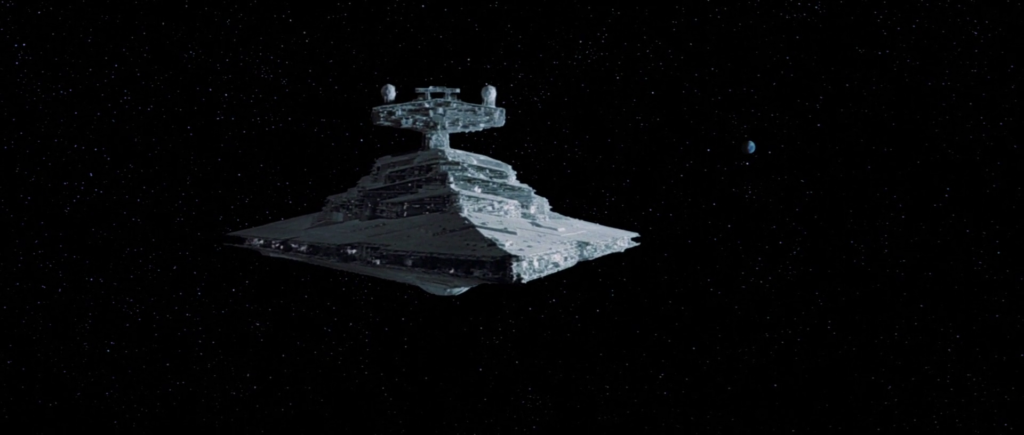
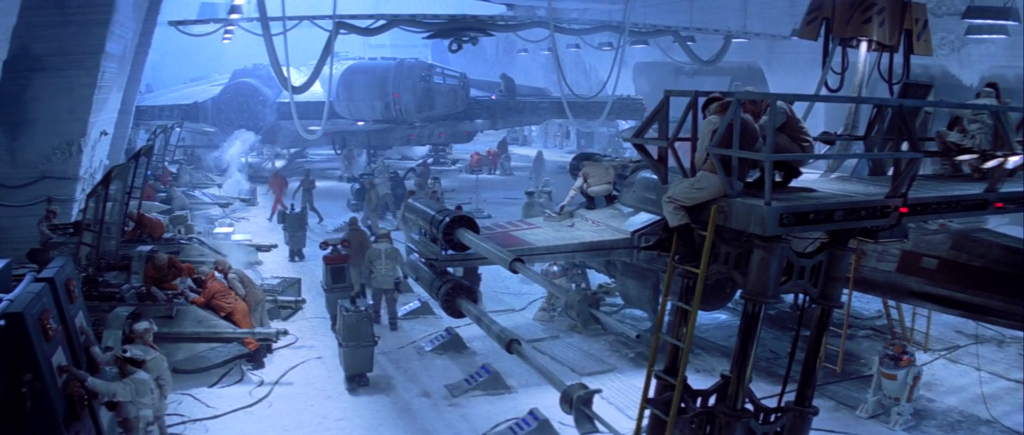







Star Wars Episode V: The Empire Strikes Back (1980)
Film review #507
Director: Irvin Kershner
SYNOPSIS: Three years after the rebel alliance successfully destroyed the galactic empire’s death star battlestation, the empire has been mercilessly hunting down the rebels and chasing them across the galaxy. The empire has chased them to their latest base in the Hoth system, and begin their assault. Luke Skywalker finds he must fulfil his destiny to become a true Jedi, and his friends evade pursuit from the empire as the stakes are elevated for all of the heroes…
THOUGHTS/ANALYSIS: Star Wars Episode V: The Empire Strikes back is a 1980 sci-fi film and the sequel to the original 1977 film Stars Wars Episode IV. Set three years after the events of the previous film, we find the heroes of the first film hiding out on an ice planet with the rest of the rebel alliance, with the Empire in pursuit. Following their success at the end of the previous film, the title of the film quickly comes to fruition, with the evil galactic empire striking back with overwhelming force. It contrasts quite a bit with the ending of Episode IV, which felt very much like a decisive victory, but then again had Darth Vader survive and showed nothing of the fallout from the Rebel’s victory. The idea of there even being a sequel after the first one was very much in doubt, so it’s fair that there would have been a lack of foreplanning in that regard. The Empire Strikes Back immediately raises the stakes in the opening act, and thrusts our heroes back into action, giving them new motivations and resolve. There’s very little breathing room in the film’s script, and nearly every moment is filled with action and energy. From a story standpoint you could probably cut the Hoth battle down fairly easily, but it’s more of a spectacle than a story impetus, and opening the film with a big action sequence will quickly satisfy those looking for an entertaining film rather than hard science-fiction. Another vast improvement in the story is how the story isn’t stringed together by a series of huge conveniences of characters being in the right place at the right time. There’s a bit of that (Such as Luke happening to crash land at the exact part of a whole planet where Yoda is), but otherwise it’s not much of an issue here.
When Empire Strikes Back was released, it received very mixed reviews: the change in tone from a more simplistic good vs evil story to a more complex world-building and darker tone might have alienated those who were simply looking for more of the same. However, that opinion has shifted quite significantly over the years, becoming a model for how sequels should be made. The film ups the stakes, builds the world, and shifts the tone to provide a new experience. The changes won’t be for everyone, but some amount of change is necessary to keep things fresh and justify actually making a sequel. Furthermore, this film has become regarded as one of the best in the series for these reasons, and it’s accomplishment in turning a fairly simple story into a franchise. The darker tone might be seen as symbolic that the series has “grown up” in some way, and that certainly seems to be what The Empire Strikes Back has been going for.
One thing that I noticed right away with regards to the characters is that even though three years have supposedly passed between this film and the last, the main characters don’t really seem to have changed in those three years. Their relationships all seem to be at a standstill waiting for this film to start. For example, the Luke-Leia-Han love triangle still seems to be a thing, which is something that seems an odd thing to string along for three years. Also that Han has still not paid Jabba the Hutt the money he is owed, despite it being stressed that it was a bit of an urgent matter previously. Apart from that, we get to see more of the character’s backstories and development, where they really start to emerge from their typical roles. Mark Hamil definitely delivers a much better performance than in A New Hope, and it’s clear to see he has been working on his skills. The new characters Yoda and Lando add in some more complexities, and Yoda is played very straight, contrasting with his appearance and clownish antics when he first appears. Obviously the big revelation that (spoilers) Vader is Luke’s Father is the biggest twist in the film, it’s definitely just a sting at the end of the film that sets the stage for the ending, with the heroes on the back-foot and out of options, ready for a redemption in the sequel. We still know very little about Luke’s Father with regards to what he did or who he was, so it doesn’t really change what we know in terms of the story, but yes it is definitely a high drama moment.
The film keeps the very distinct aesthetic divisions between the Empire and the rebels, with the sleek, clean Empire ships contrasting with the more dishevelled, cobbled together Rebel devices. The sets have plenty of detail and complexity to build its world. It gives sci-fi fans plenty of spaceships, lasers, and the like, while still having a sensible story to follow. As I’ve mentioned before, I’m not a Star Wars fan, and there’s probably no film that is going to make me change my mind. The flaws I see in this film stick out because of this, but I can also see how this film works as a successful sequel: it expands the world, deepens the characters, and raises the stakes to give you more of what you like (if you already like it).
-
#506 – The Hyperions (2022)








The Hyperions (2022)
Film review #505
Director: Jon McDonald
SYNOPSIS: In 1960, Professor Ruckus Mandulbaum invented the Titan badges: special devices that when worn could turn anyone in to a superhero. He adopted two young orphans and a third person to become a team of superheroes. As time went on, different heroes took up the titan badges as the original heroes moved on with their lives. In 1979, two of the original superheroes want their badges back, and take hostages until Mandulbaum agrees to release them…
THOUGHTS/ANALYSIS: The Hyperions is a 2022 sci-fi film. The film revolves around a group of people given superpowers by Professor Mandulbaum and his inventions, the titan badges. In 1979, nearly twenty years after they were first invented, two members of the first generation to wear the badges stage a robbery to try and get them back, realising that they need Mandulbaum’s help to do it. Despite looking like a superhero film on the surface, it focuses more on being a drama and the relations between the characters, with a hint of light-comedy thrown into the mix. The plot is pretty threadbare, and the whole premise of the film is laid out early on for the drama to unfold. The plot tries to raise the stakes by revealing the motivations of the characters, but it never really adds anything surprising or captivating to change the state of play. The constant back and forth with flashbacks revealing parts of the story really staggers any kind of progression as well. The pacing, especially near the end, is very rough.
Being a superhero film actually plays very little role in the overall story, and as mentioned it’s very much focused on the characters. Maybe the point is to do something “different” with superhero characters and look at their humanity, but this is something that has been done to death with trying to show a “different” side to them outside of their superhero persona. While this usually results in making them angsty and tormented in comparison to their heroic status, The Hyperions seems to instead try to humanise them by focusing on the relationships between the characters, and the strain put upon them through being a superhero. Their disagreements and tensions are relatable, but maybe too much so: the superhero set-up in fact has very little effect on the content of the film, and while it can be good to have certain expectations subverted, instead the film just replaces it with…very little. The main characters have specific personalities and motivations, but the main cause of tension and drama between the characters is skirted around, and when it is addressed, is rushed and unrewarding. Aside from the main characters, there are a few support characters, but none of them really have an impact either. It is perhaps worth mentioning that this film is backed and produced by the Daily Wire, who have dipped their toes into filmmaking as a response to Hollywood’s “agenda,” in defence of free speech or something. So departing from Hollywood superhero films, they have instead used their free speech to make a film that actually says very little, which I think is quite interesting. It feels like it’s so hyper-conscious of not having any political message to preach that it just ends up being vacuous at it’s core. Superheroes are political, and they do have a message to convey: trying to erase that misses the point entirely. It might be trying to reinforce traditional family values as the solution to all troubles, which seems to be the justification of the ad-hoc ending where everything works out because they’re family, but if that is the point, then the film ends up looking seriously naïve.
One of the most unique aspects of the film is the use of a 60′s animated aesthetic that is reminiscent of Disney films. Animated characters and effects overlap with the real-world, which provides some interesting visuals, but it just feels like there’s no purpose to it as a cinematic choice: it’s not parodying it, and the film isn’t structured or feature similar characters or plot points to those films. Combine this with the recurring problem of interrupting the film along with the flashbacks, and it ends up complicating the film without adding anything of significance. The sets look good, and have a particular aesthetic with it’s 60′s technicolour vibe, but other than that nothing really stands out on that front. Some of the lacklustre elements of this film can perhaps be put down to it being a directorial debut, but there definitely is a problem with the film being reluctant to say anything of importance, and as mentioned above, I think it has something to do with the people behind it rebelling against Hollywood’s perceived “agenda” and some imagined defence of free speech to the point that it has nothing to really say. there are some good points to this film: there are some good dramatic moments and emotional scenes between some of the characters, but a haphazard structure, bad pacing, confused comedic choices, and a jumble of aesthetic choices that combine to make The Hyperions an overall dull and meandering experience.
-
#505 – Space Truckers (1996)










Space Truckers (1996)
Film review #505
Director: Stuart Gordon
SYNOPSIS: John Canyon is hauling a shipment of hogs to a remote space station. Failing to get paid, he takes on another job to deliver a secret and sketchy cargo to Earth. When John’s truck is hijacked by raiders, they open the cargo and inadvertently release an army of killer robots. John and his crew must stop the robots before they can get to earth and cause untold destruction to the planet…
THOUGHTS/ANALYSIS: Space Truckers is a 1996 sci-fi film that is succinctly described by it’s title: it’s about truckers in space. John Canyon (Dennis Hopper) is hauling twenty-thousand tons of hog fat to Titan Station. However, because he is late, his employer refuses to pay him the full amount. Now broke and without a job, he takes on a seedy contract to take an unknown cargo to Earth. Taking along Cindy, a waitress who needs a lift to Earth, and Mike, a newly qualified space trucker, the three set off with their cargo to Earth in this film that feels so very quintessentially 90′s. The bright colours, comedic tone give off the impression of a typical sci-fi b-movie parody, but there’s more to it than meets the eye. The story is a little threadbare and takes a while to get into the heart of the story, but it takes its time to introduce a fair amount of detail into the world. Regardless, it’s still a fairly simple story to follow, and all the plot points are familiar and fun: it’s basically just trucking in space, but it allows for some entertaining set ups and fun across the board, with even a few twists thrown in to keep things interesting. There’s a mix of comedy, action, parody and even some darker thriller elements in the film, which is a lot to take in, but it handles the constant switching well. The film obviously tries to appeal to a wide audience and not get entrenched too much in one genre or another.
The characters should feel very familiar to viewers: John Canyon, portrayed by Dennis Hopper is the grizzled trucker veteran who teaches waitress Cindy and new driver Mark about the trucker lifestyle (along with the viewer). A host of smaller support characters are vividly brought to life and serve very specific purposes making them stand out, just not in any unique way, and even though the acting can sometimes feel a little flat, on the whole the casting feels pretty solid. In classic sci-fi fashion the world it creates feels different, yet familiar: the diner where one of the opening scenes takes place looks like a typical American diner, but has a sci-fi twist with it being a zero-gravity “wheel” shape obviously inspired by 2001: A Space Odyssey. We don’t get too much information about what it is like on Earth, but that perhaps enhances the feel of being a trucker; out on the road far from civilisation.
For a middle-of-the-road sci-fi movie that meanders between action and comedy, Space Truckers has an impressive amount of effort put into it’s designs and production. The models used for the spaceships have plenty of detail to catch your attention, and they look very sturdy. The killer robots were designed by noted Japanese illustrator Hajime Sorayama, who specialises in these types of creations, and again they are brought to life brilliantly, both in terms of their construction and their choreography. There are some weaker elements in the production though: the CG is pretty bad, but thankfully it is used very sparingly, and the majority of the effects are practical. Also you can often see the strings attached to the actors when they are “floating” in zero gravity. These are minor things that don’t really distract from a fun experience though. Space Truckers isn’t ground-breaking, but it’s a good mix of genres that makes an entertaining watch, that quietly stands out in terms of some of it’s production and design.


